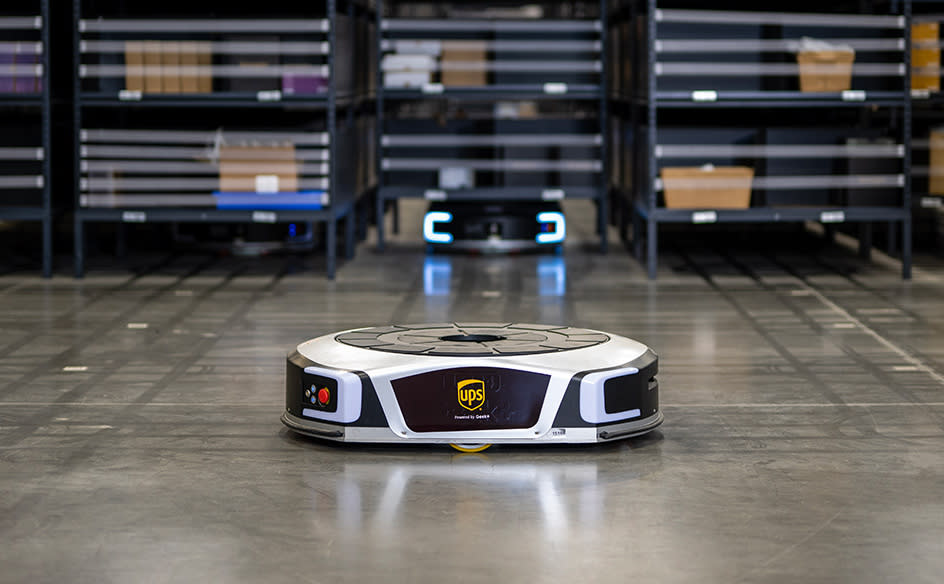FedEx, UPS Double Down on Robotics

FedEx and UPS are deploying more robotics technologies within their fulfillment networks, both touting advancements in artificial intelligence (AI) as a means to simplify physical labor.
Dexterity AI has collaborated with FedEx to leverage AI-powered robotics that help load boxes into trucks and trailers. The technology was unveiled Tuesday at a joint event, called Unlock the Dock, held in San Francisco.
More from Sourcing Journal
UPS Hiring 100,000 This Holiday in 'War for Seasonal Talent'
Adidas Opens New Distribution Center in China Powered by Robots
The technology is designed to automate the arduous task of manual truck loading, particularly in alleviating the difficulty of stacking shipments that flow through the FedEx network, which vary in size, shape, weight and packaging material.
Dexterity AI’s proprietary mobile robot design, DexR, is built to navigate autonomously to the back of trailers and can connect to a powered conveyor system that feeds the robot boxes directly from the sortation system. The DexR’s two-arm design enables the robot to pick and pack boxes simultaneously, improving throughput.
The tech focuses on the complexity of truck loading by giving mobile robots a suite of intelligence ranging from the ability to see, touch, think, and move quickly to pack trailers with stable, dense walls of randomized boxes.
DexR has a feature called “generative wall planning,” in which, Dexterity’s AI software takes 500 milliseconds or less to assess billions of wall-build possibilities to pack trailers tightly. According to the company, the software’s AI-powered “force control” enables the robots to gently nudge boxes together and create more tightly packed walls.
Machine learning-based pack improvement capabilities are designed to help ensure that with every box picked, the Dexterity AI truck-loading software becomes even more efficient in handling a broader range of packing challenges.
By integrating its own trajectory and motion planning, the Dexterity AI platform helps the DexR’s two arms move quickly inside trailers without colliding with each other or the truck walls.
Like FedEx, UPS is leveraging robotics to help reduce repetitive tasks and physical stress while promoting worker safety. The technologies also aim to improve package flow and the package delivery network’s overall efficiency.
The improvements target processes including pick-and-place, loading and unloading, and moving irregular-sized shipments.
UPS is using pick-and-place technologies powered by Dexterity AI, Fortna and Plus One Robotics to help employees sort small packages. The firm is using unloading technologies from Pickle Robot to ease the job of unloading trailers.
The company is using autonomous guided vehicles (AGV) powered by Dane Technologies, Geek+, Locus Robotics, Crown Lift Trucks and Toyota-Raymond, in an effort to more safely and easily move small packages and irregular-sized shipments through UPS facilities.
Irregular shipments don’t fit on conveyor belts and often can be heavy and difficult to move. These vehicles can exponentially streamline these movements, UPS said.

America’s largest package delivery company had been hinting at more automation initiatives, with CEO Carol Tomé saying in an August earnings call that UPS had been introducing new tech like automated label application, automated bagging and robotic small sort induction in its facilities.
As of last month, 57 percent of UPS’ package volume flows through an automated hub, compared to 53 percent in the year prior, according to Tomé.
The developments come as demand for robotics solutions has slowed down across industries.
According to an August report from the Association for Advancing Automation (A3), companies ordered 7,697 robots valued at $457 million from April to July 2023, a 37 percent decline in robot orders over the same period in 2022. This marks the second quarter in a row the amount of robotics orders declined, the associate said.
While there’s some pushback among employees worried about the growth of robotics in the supply chain, it appears the slowdown in purchases is more due to macroeconomic concerns.
Alex Shikany, vice president of membership and business intelligence, A3, said that while there was a post-Covid surge in orders last year, companies have since pulled back spending mainly because the slow economy and high interest rates.
“While many companies continue to automate, others just don’t have the capital to invest right now, despite their struggle to find workers willing to do many of the dull, dirty and dangerous jobs that remain unfilled,” Shikany said.
A September report from Prologis is still bullish on the long term application of robotics within the supply chain. Automation adoption, led by autonomous mobile robots (AMRs), will see a meaningful expansion, the report said, increasing role quality, employee productivity and compensation all at once. Up to 50 percent of logistics operations could include AMRs over the next decade, the real estate investment trust (REIT) predicts.

